Today, we bring you a fascinating glimpse into the enchanting world of the Ruby-Throated Hummingbird. These tiny creatures have captivated humans for centuries with their vibrant colours and lightning-fast movements. This blog post will delve into their history, share interesting facts, discuss their size and habitat, and provide their classification.
The Ruby-Throated Hummingbird has quite an intriguing past. Native to the Americas, it has been a symbol of joy, love, and energy for many cultures throughout history. Its name comes from the striking ruby-red throat found in adult males. These birds have been admired and studied by bird enthusiasts and scientists alike, who are in awe of their unique characteristics.
Now, let’s dive into some fascinating facts about these magnificent birds. Did you know that Ruby-Throated Hummingbirds are the only species that regularly breed east of the Mississippi River? They are also known for their incredible speed, flapping their wings up to 53 times per second! These tiny birds weigh about three to four grams, about a penny’s weight.
Regarding their habitat, ruby-troated hummingbirds can be found in various environments, including forests, gardens, and even urban areas. Their preferred areas offer a mix of trees for nesting and open spaces with flowers for feeding on nectar. Their delicate size allows them to hover, and their long, thin beaks are perfectly designed for sipping nectar from blossoms.
The Ruby-Throated Hummingbird presents a captivating subject for anyone interested in birds. Their history, facts, size, habitat, and classification make them a fascinating species to explore. Stay tuned for our upcoming articles on various other animals as we expand our informative and engaging content collection.
History of Ruby-Throated Hummingbird
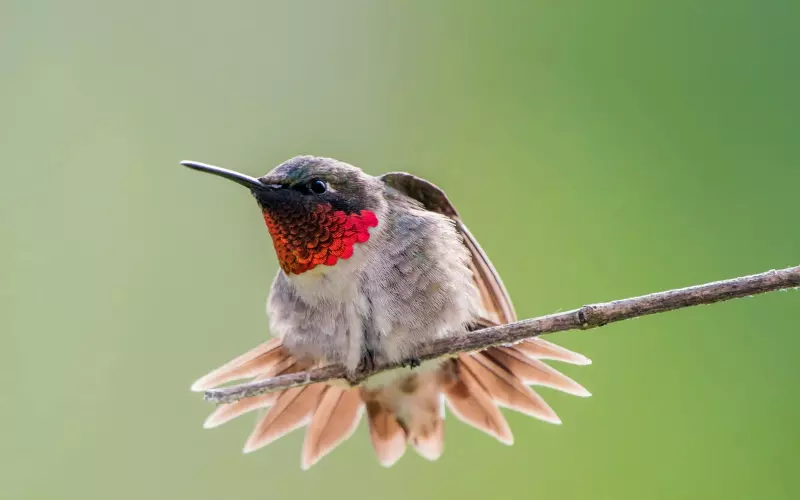
The Ruby-Throated Hummingbird is a fascinating creature with a long and exciting history. These tiny birds are native to North America and have been admired by people for centuries.
The history of the Ruby-Throated Hummingbird can be traced back to ancient times when indigenous tribes crossed paths with these magical birds. Native Americans believed that hummingbirds were messengers of joy and brought good luck and fortune. They even incorporated their symbolism into their art and storytelling.
As time went on, European settlers arrived in North America and were captivated by the beauty and agility of the Ruby-Throated Hummingbird. They marvelled at their ability to hover in the air and their vibrant colours. Many early explorers and naturalists documented their encounters with these birds, helping to spread knowledge and awareness about them.
Today, the Ruby-Throated Hummingbird continues to thrive in North America. It plays a vital role in pollination, as it feeds on nectar from various flowers. Its unique flying abilities and distinctive ruby-red throat make it a beloved visitor to gardens and parks. Despite its small size, the Ruby-Throated Hummingbird is prominent in the hearts of nature enthusiasts everywhere.
Importance of Ruby-Throated Hummingbird

The Ruby-Throated Hummingbird is a significant bird in our ecosystem. Despite its small size, it plays a big role in pollination. When the Ruby-Throated Hummingbird visits flowers to sip nectar, it inadvertently transfers pollen from one flower to another, allowing plants to reproduce. This helps plants produce more fruits, seeds, and flowers, which benefits other animals that rely on these for food. So, we can say that the Ruby-Throated Hummingbird helps to keep our environment beautiful and thriving.
Another critical role of the Ruby-Throated Hummingbird is in controlling the population of insects. These tiny birds feed on insects like mosquitoes, gnats, and spiders. By eating these insects, the Ruby-Throated Hummingbird helps to keep their populations in check, reducing the risk of insect-borne diseases and maintaining the balance of our ecosystem.
Lastly, the Ruby-Throated Hummingbird is a delight to watch and admire. Their vibrant colours and quick movements bring joy to many people, sparking curiosity about the natural world. Observing these birds encourages us to appreciate the beauty of nature and understand the interconnectedness of all living beings.
The Ruby-Throated Hummingbird plays a vital role in pollination, helps control insect populations, and brings joy to those who observe them. Its presence and activities create a healthy, diverse, and beautiful environment.
Amazing Facts About Ruby-Throated Hummingbird
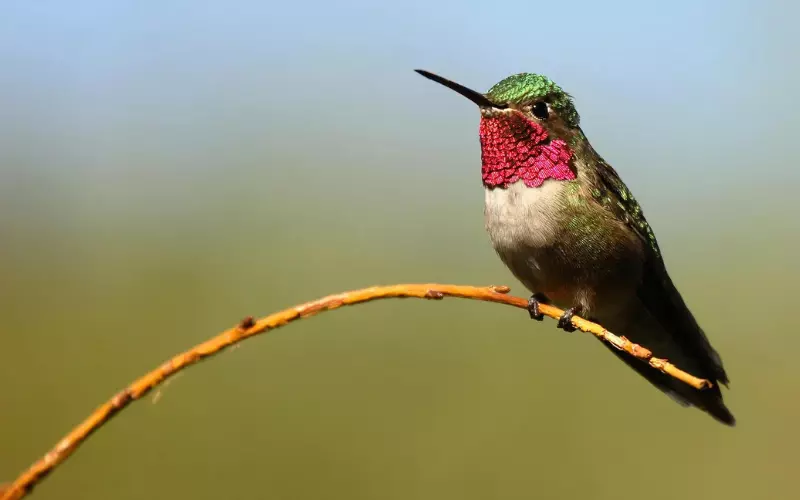
1. The Ruby-Throated Hummingbird is one of the smallest bird species in North America, measuring only about 3 to 4 inches long.
2. This hummingbird species is mainly found in eastern North America during summer when they migrate from Central America and Mexico.
3. The males of this species are known for their vibrant ruby-red throat or “gorget,” which shimmers in different angles of light.
4. Female Ruby-Throated Hummingbirds have a more subdued appearance, with green back feathers and white underparts.
5. These birds have a very fast wingbeat, reaching approximately 53 beats per second, allowing them to hover and even fly backwards.
6. Despite their small size, Ruby-Throated Hummingbirds have a high metabolism and must consume large amounts of nectar to fuel their energy.
7. To feed, these hummingbirds hover in front of flowers, extending their long, thin beaks deep into the blossoms to reach the nectar.
8. Besides nectar, these birds also eat insects and spiders, which provide them with the necessary protein for their diet.
9. Ruby-throated hummingbirds are pretty territorial and will fiercely defend their feeding and nesting areas from other hummingbirds and even larger birds.
10. During courtship displays, male hummingbirds perform acrobatic flight patterns, creating a buzzing sound with their wings to attract the females.
11. Female Ruby-Throated Hummingbirds build tiny cup-shaped nests using spider silk and soft materials like plant down, moss, and lichens.
12. The female typically lays two pea-sized eggs in her nest, which she incubates for about two weeks until they hatch.
13. Once the chicks are born, both parents take turns feeding them a diet of nectar and small insects until they can fly and forage independently.
14. Ruby-throated hummingbirds are known for their long-distance migration, flying nearly 600 miles nonstop over the Gulf of Mexico during their fall migration.
15. Conservation efforts, such as planting native nectar-rich flowers and avoiding the use of pesticides, can help support these beautiful birds and their vital role as pollinators.
Can we keep a Ruby-Throated Hummingbird as our Pet?
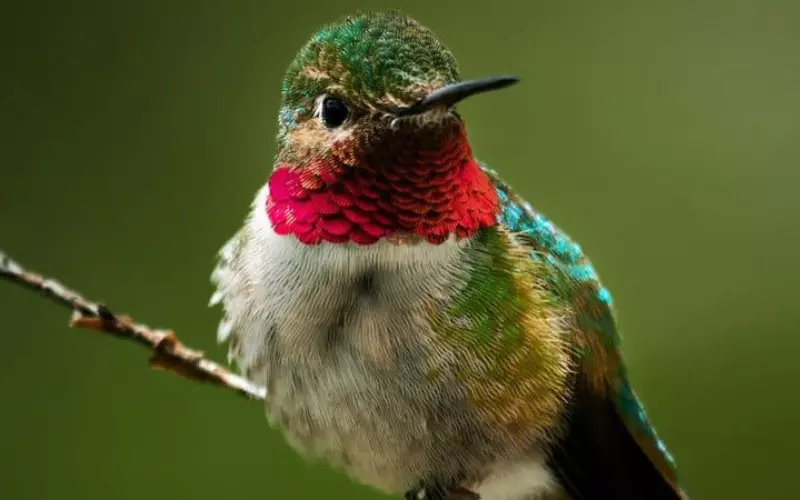
Ruby-throated Hummingbirds are lovely creatures found in North America. They are the smallest species of hummingbirds, known for their vibrant, shimmering feathers and ability to hover mid-air. While they are fascinating to observe, keeping them as pets is not suitable or ethical.
Ruby-throated Hummingbirds are wild birds and should be allowed to live freely in their natural environment. They thrive in forests, gardens, and meadows where they can find nectar from flowers and insects for food. Because of their small size and specific dietary needs, it is challenging to recreate their natural habitat in captivity. Unlike larger birds, such as parrots, hummingbirds do not adapt well to life in cages.
Furthermore, it is essential to note that Ruby-throated Hummingbirds are not extinct. They are listed as a species of most minor concern on the International Union for Conservation of Nature (IUCN) Red List. However, many other bird species have unfortunately become extinct due to habitat loss and climate change. We are responsible for protecting and preserving these beautiful birds’ habitats rather than keeping them as pets.
Keeping Ruby-throated Hummingbirds as pets is not recommended or even possible. These small and delicate birds are best left to fly freely in nature, where they can fulfil their ecological roles and contribute to the beauty of our environment. By respecting their natural habitat and understanding the importance of conservation, we can help ensure the survival of these fascinating creatures for generations to come.
Size of Ruby-Throated Hummingbird

The Ruby-Throated Hummingbird bird is one of the smallest bird species in the world! It is a tiny little creature that measures only about 3 to 3.75 inches long, about the size of a small pencil or a large paperclip. Can you imagine how tiny that is?
These birdies weigh only about 0.1 to 0.2 ounces, equal to the weight of a couple of grapes or a nickel. Their slender bodies and wings can beat incredibly fast, around 55 times in a second! Due to their small size, they are often mistaken for insects when they zoom around in the air.
Even though they are so little, Ruby-Throated Hummingbirds are amazing flyers. They can fly forward, backwards, and even hover in one spot! They can also fly high, reaching heights of up to 50 feet. It’s like having a tiny acrobat in your backyard.
The Ruby-Throated Hummingbird is a tiny bird, measuring just a few inches long and weighing only a fraction of an ounce. They are small but mighty, able to fly in all directions and reach great heights. It’s astonishing how nature can create such incredible creatures in such a small package.
Habitat of Ruby-Throated Hummingbird
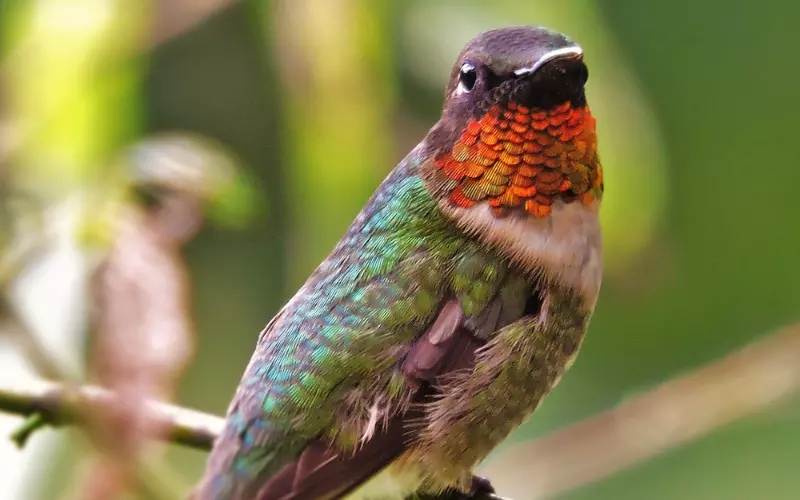
Ruby-throated hummingbirds are tiny, colourful birds with bright red feathers on their throats. They are found in different parts of North America, particularly in the eastern regions. These amazing birds have a unique habitat that suits their needs.
The ruby-throated hummingbirds prefer to live in forests, woodlands, and gardens with plenty of trees and flowers. They need areas with lots of nectar-producing flowers to feed on. They also need tall trees to perch on and rest. These birds are highly skilled flyers and can hover in mid-air, so they require open spaces with enough room to fly around and perform their aerial acrobatics.
A critical feature of the ruby-throated hummingbird’s habitat is the presence of water sources. They need accessible water to drink and bathe in. Ponds, streams, and birdbaths are ideal for these tiny birds. Access to water is crucial for their survival, especially during hot summer months when water can be scarce.
The habitat of the ruby-throated hummingbird includes forests and gardens with lots of nectar-producing flowers, tall trees for perching, open spaces for flying, and water sources for drinking and bathing. These beautiful birds rely on their habitats to provide them with food, shelter, and safety. Preserving and protecting their natural habitats is essential for ensuring the well-being and survival of these beautiful creatures.
Evolution of Ruby-Throated Hummingbird
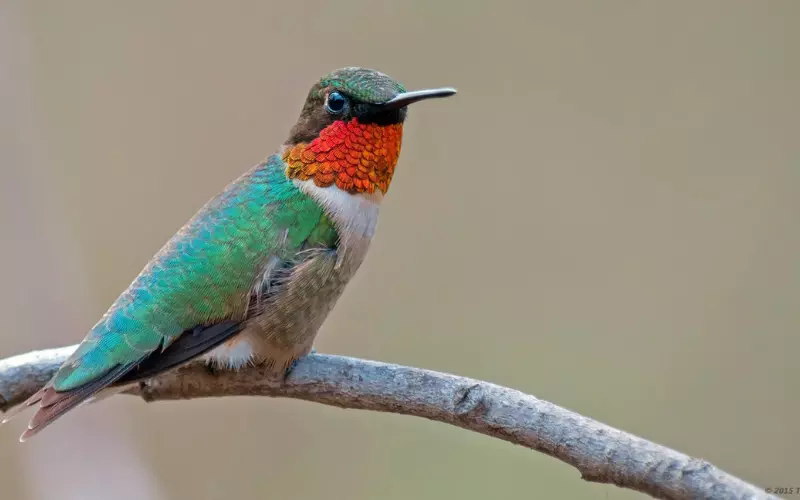
The Ruby-Throated Hummingbird bird has undergone a fascinating process known as evolution. Over millions of years, this bird has adapted and changed to survive in its environment. Let’s explore its evolution in three paragraphs.
In the beginning, the ancestors of the Ruby-Throated Hummingbird were ordinary birds with no special features. But as time passed, some birds developed unique characteristics that helped them survive better. For example, their wings gradually became smaller, allowing them to hover in the air longer. This adaptation was beneficial when searching for food or avoiding predators. Additionally, their beaks elongated and became slender, which helped them reach deep into flowers to reach nectar. These changes allowed the hummingbirds to find more food and survive.
As the years went by, the ongoing evolution led to the Ruby-Throated Hummingbird we see today. Their bright, ruby-colored throats became more prominent, attracting potential mates and deterring rivals. This distinctive feature made it easier for the birds to find a mate and ensure the survival of their species. Another significant change was the size of their bodies. Ruby-throated hummingbirds are small and lightweight, which allows them to fly swiftly and navigate through narrow spaces. These advancements helped them become one of the fastest animals on Earth, with wings that can flap up to 80 times per second!
The Ruby-Throated Hummingbird’s evolution is remarkable, highlighting how small changes can lead to incredible adaptations over time. These birds have transformed from tiny wings to elongated beaks to fit their environment. Their vibrant ruby-throats and tiny bodies make them unique and enable them to thrive in their habitats. The evolution of the Ruby-Throated Hummingbird bird truly showcases the wonders of nature and the incredible diversity of life on our planet.
Classification of Ruby-Throated Hummingbird
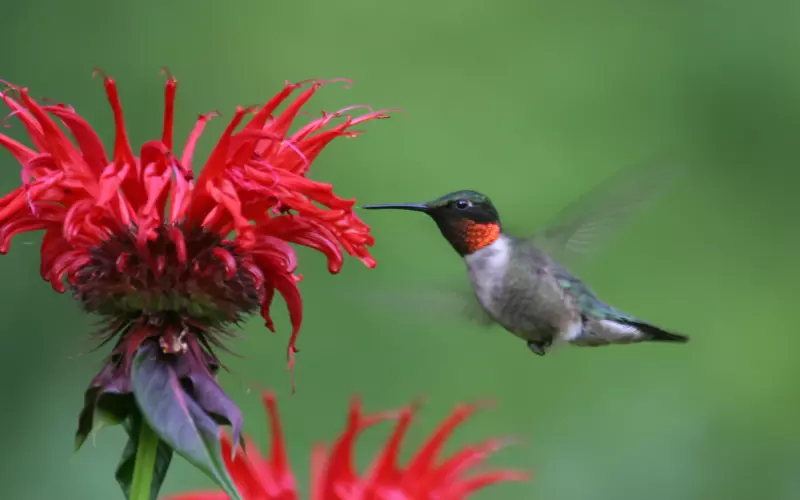
The Ruby-Throated Hummingbird is a small and colourful bird in North and Central America. It belongs to the animal kingdom, the phylum Chordata, and the class Aves, which includes all birds. This beautiful bird is further classified into the order Apodiformes and the family Trochilidae.
Regarding its physical features, the Ruby-Throated Hummingbird measures around three to four inches in length and weighs just a few grams. It has vibrant green feathers on its back and head, while its throat is bright red, hence its name. The wings of the Ruby-Throated Hummingbird are long and narrow, allowing it to hover mid-air while feeding on nectar from flowers.
Ruby-throated hummingbirds are known for their incredible flying abilities. Thanks to their strong wings and rapid wing beats, they can fly forwards, backwards, and even upside down. These little birds feed mainly on flower nectar, giving them the energy they need to sustain their high metabolism. Additionally, they also consume insects and spiders for protein.
The Ruby-Throated Hummingbird belongs to the animal kingdom, the phylum Chordata, and the class Aves. It is classified as a member of the order Apodiformes and the family Trochilidae. These tiny birds have bright green feathers, a vibrant red throat, and can fly in all directions. They feed on nectar from flowers and also eat insects and spiders. The Ruby-Throated Hummingbird is truly a remarkable and fascinating bird in nature.
Different Types of Ruby-Throated Hummingbirds
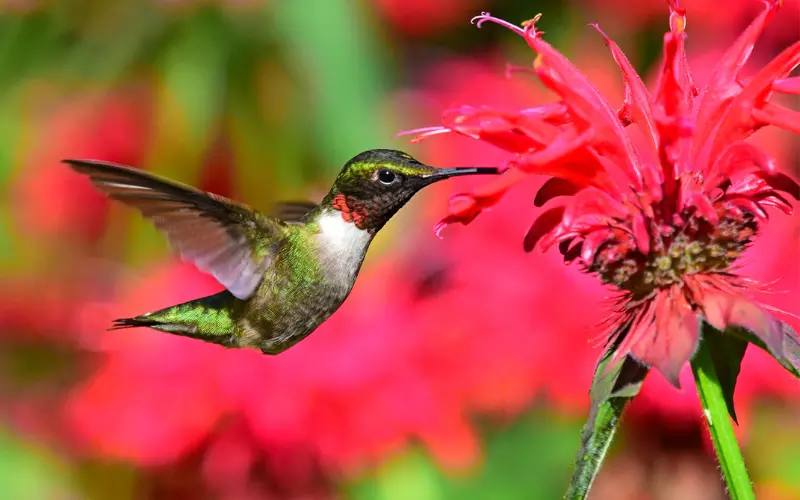
1. Male Ruby-Throated Hummingbirds have a vibrant iridescent green plumage on their upper body, while their throat and crown shine brilliant red. This striking colouration helps them attract mates and defend their territories.
2. Female Ruby-Throated Hummingbirds have a more subdued appearance than males, with green upper feathers and a slightly less conspicuous ruby-red throat. This helps them blend with their surroundings while protecting their nests.
3. Juvenile Ruby-Throated Hummingbirds resemble females but often have a scraggly appearance with less-defined colours. They learn from their parents and begin developing their unique behaviours and calls.
4. Ruby- Throated hummingbirds feed on various nectar-rich flowers, using their long, thin bills to sip the sugary liquid. They are exceptional pollinators, transferring pollen from one flower to another as they drink.
5. These birds can hover in mid-air, using their incredibly fast wingbeats to maintain their position. They can beat their wings up to 80 times per second, allowing them to extract nectar efficiently.
6. Ruby-throated hummingbirds have an extremely high metabolism, requiring them to consume about half their body weight in nectar daily. They also supplement their diet with small insects and spiders to obtain protein.
7. These birds undertake impressive migratory journeys, flying non-stop for up to 500 miles across the Gulf of Mexico in spring and fall. They rely on fat reserves to sustain them during these long flights.
8. Ruby-throated hummingbirds build delicate cup-shaped nests using plant fibres, lichens, and spider silk. They carefully camouflage their nests within dense foliage, protecting their eggs and young.
9. Like many other bird species, Throated Hummingbirds engage in courtship displays to attract mates. Males perform aerial acrobatics, displaying their vibrant throat colours and producing distinctive dive-bombing sounds to gain the female’s attention.
10. Ruby-throated hummingbirds have a unique ability to enter a state of torpor, slowing down their heart rate and metabolism during periods of cold temperature or scarcity of food. This adaptation helps them conserve energy and survive unfavourable conditions.
Geographical Presence of Ruby-Throated Hummingbird
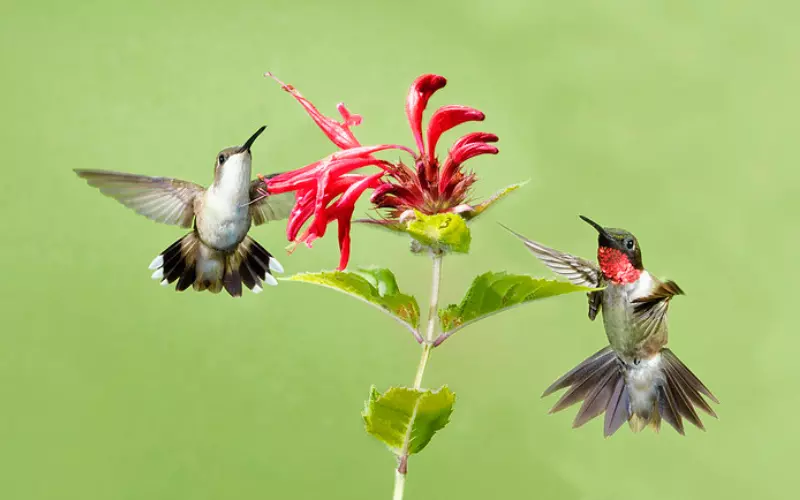
The Ruby-Throated Hummingbird is known to be found in some areas of the world. One of these regions includes the eastern part of North America, from Canada down to Mexico. These colourful little birds can be seen fluttering around gardens, parks, and forests in this part of the world. They are attracted to areas with plenty of flowers and nectar, their main food source.
However, there are other regions where the Ruby-Throated Hummingbird is not found. One such region is the western part of North America. This includes states such as California, Oregon, and Washington. These areas are not home to the Ruby-Throated Hummingbird but have different species of hummingbirds adapted to the local environment. So if you happen to live in the western part of North America, you may not be lucky enough to observe these lovely birds in your backyard.
In addition to North America, the Ruby-Throated Hummingbird is also found in certain regions of Central America and the Caribbean. These areas provide a warm and tropical climate suitable for the birds’ migratory patterns and breeding habits. So, if you happen to live in countries like Costa Rica, Belize, or Jamaica, you may have the opportunity to spot these vibrant hummingbirds.
The Ruby-Throated Hummingbird is found in the eastern part of North America, from Canada to Mexico, as well as in some regions of Central America and the Caribbean. However, they are not found in the western part of North America. These little birds delight us with their vibrant colours and ability to hover mid-air, making them a wonderful sight in their home regions.
Scientific Name of Ruby-Throated Hummingbird
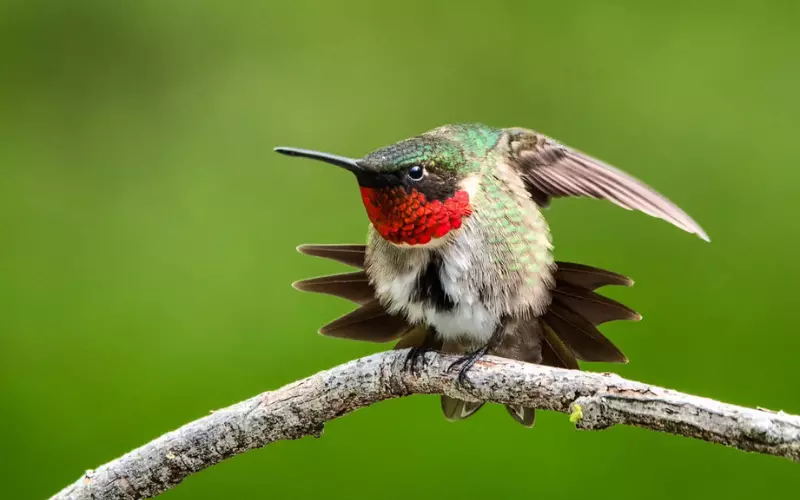
The scientific name of the Ruby-Throated Hummingbird bird is Archilochus colubris. Scientists often use scientific names to classify and identify different species of animals and plants. The Ruby-Throated Hummingbird is a small bird commonly found in North America.
The first part of its scientific name, Archilochus, derives from the Greek poet Archilochus, known for his sharp and quick-witted verse. This name was chosen because hummingbirds are known for their agility and quick movements. The second part of its scientific name, colubris, means “snake-like” in Latin. This term refers to the hummingbird’s long, slender body shape, similar to a snake’s.
The Ruby-Throated Hummingbird is known for its vibrant ruby-red throat, which shines in the sunlight. It is one of the smallest bird species in North America, measuring only about three to four inches in length. These birds are famous for their ability to hover in mid-air and fly backwards, thanks to their unique flying capabilities. They also have a rapid wingbeat, reaching up to 53 beats per second.
The scientific name of the Ruby-Throated Hummingbird is Archilochus colubris. It is a small bird with a ruby-red throat, found in North America. This incredible bird is admired for its agility, quick movements, and unique flying abilities.
Diet of Ruby-Throated Hummingbird
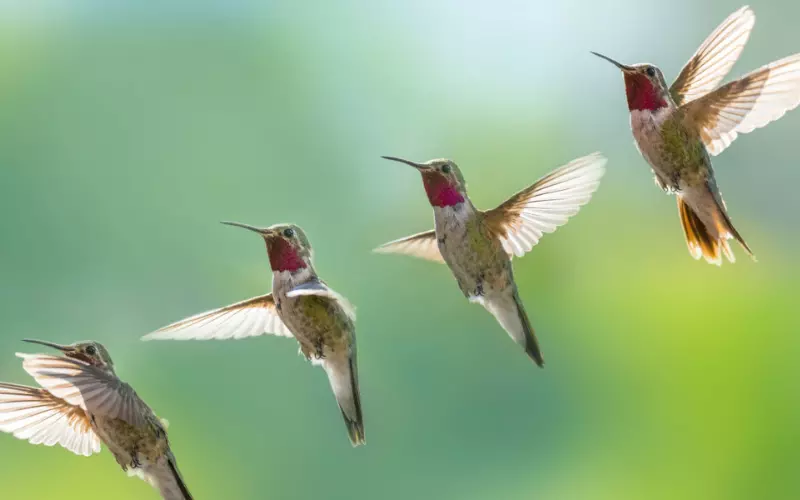
The Ruby-Throated Hummingbird bird, known for its vibrant colours and swift flight, has a diverse and exciting diet. These tiny birds rely primarily on nectar from flowers to survive. They have long, thin beaks perfectly adapted for sipping nectar deep inside flowers.
However, nectar alone is not enough to provide all the necessary nutrients to keep the hummingbirds healthy. To meet their nutritional needs, they also eat small insects and spiders. They catch these small creatures by hovering in midair and using their long beaks to pluck them from leaves or catch them in the air. Insects and spiders are an important source of protein for hummingbirds, helping them to grow and stay strong.
In addition to nectar and insects, the hummingbirds also sip on tree sap from small holes made by woodpeckers. This sticky substance provides them with carbohydrates and other essential nutrients. They are attracted to the sap’s sweet taste and often compete with other birds for this valuable food source.
The diet of the Ruby-Throated Hummingbird is diverse and fascinating. They primarily feed on nectar from flowers but consume insects and spiders for protein. Additionally, they enjoy sipping on tree sap for carbohydrates. By incorporating these different food sources into their diet, hummingbirds can maintain their energy levels and thrive in their natural habitat.
Locomotion of Ruby-Throated Hummingbird
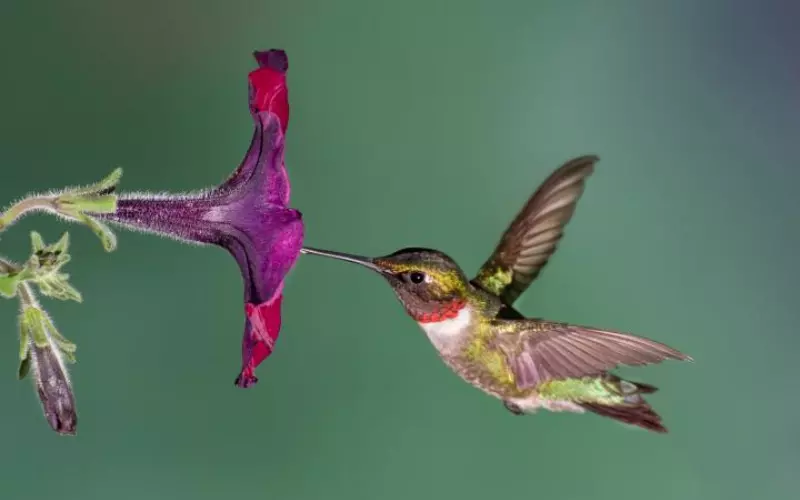
The Ruby-Throated Hummingbird is a special kind of bird that moves excitingly. It has a unique way of flying called “hovering”. This means it can stay in one place in the air, just like a helicopter! Unlike other birds that flap their wings up and down, the Ruby-Throated Hummingbird flaps its wings so fast that they become invisible! It can beat its wings up to 80 times per second!
When a Ruby-Throated Hummingbird wants to move forward, it leans slightly forward and moves its wings in a figure-eight pattern. This helps it to create lift and move smoothly through the air. It can fly in all directions – up, down, sideways, and even upside down! It is also swift and can reach up to 30 miles per hour! These tiny birds have incredible locomotion abilities that allow them to move and fly, like other animals.
Social and Sexual Behaviour of Ruby-Throated Hummingbird

Hummingbirds are tiny birds famous for their incredible ability to hover in mid-air and rapid wing beats. They have vibrant feathers with a wide range of colours. They are very social creatures and often share feeding territories with other hummingbirds.
Regarding their sexual behaviour, male hummingbirds wear spectacular courtship displays to attract females. They perform elaborate aerial displays, flying high into the sky and diving down rapidly while making buzzing sounds with their wings. These displays demonstrate the male’s fitness and strength to potential mates. The female hummingbirds select their partners based on these displays, choosing the males who perform the most impressive show.
Once the female selects a male, they engage in a short mating ritual, usually for a few seconds. After mating, the female hummingbird constructs a small nest using leaves, moss, and spider silk, which sticks everything together. She lays eggs inside the nest and carefully incubates them until they hatch. The female hummingbird raises the chicks and feeds them with nectar and insects until they leave the nest.
Hummingbirds are highly social creatures that often share feeding territories. Male hummingbirds perform elaborate courtship displays to attract females. The females select their mates based on these displays. Once a female has chosen a mate, they engage in a brief mating ritual, and the female is solely responsible for raising the chicks.
Reproduction and Lifecycle of Ruby-Throated Hummingbird
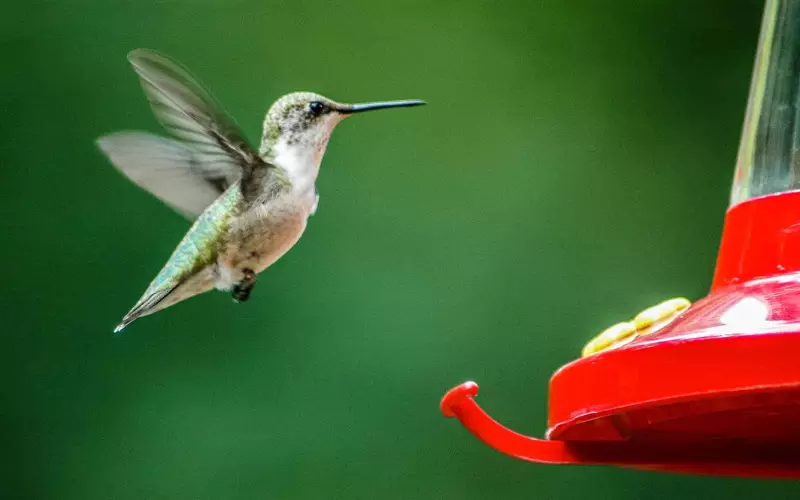
The Ruby-Throated Hummingbird is a tiny bird that lives in North and Central America. They have a fascinating life cycle and reproduction process.
First, let’s talk about their life cycle. The life of a Ruby-Throated Hummingbird begins as an egg. The bird lays its eggs in a small plant-material nest, usually in a tree. The mother bird takes care of the eggs by keeping them warm until they hatch. Once the eggs hatch, the baby hummingbirds are called chicks. The chicks are very tiny and have no feathers at first. They rely on their mother to bring them food, usually nectar from flowers. As they grow, feathers appear, and the chicks practice flying until they can do it independently. Eventually, they become adult hummingbirds and are ready to start the process again by laying their eggs.
Now, let’s talk about their reproduction process. The Ruby-Throated Hummingbird has a unique way of finding a mate. During the breeding season, the male hummingbirds perform fancy displays to attract the females. They fly up high in the air and buzz with their wings. The females watch the males’ performances and choose the one they like the most. Once a male and a female choose each other, they mate by coming close and touching their beaks together. The male does not help raise the babies, though. That job is done by the female alone. She builds the nest, lays the eggs, and cares for the chicks until they are ready to leave.
Threats to Ruby-Throated Hummingbird

Several threats pose a danger to the Ruby-Throated Hummingbird bird. One threat is habitat loss. Humans cut down forests where these birds live to make space for buildings and farms. When their homes disappear, it becomes harder for them to find enough food and shelter. This is a big problem because these little birds need lots of flower nectar to survive.
Another threat to these hummingbirds is the use of pesticides. Farmers sometimes spray these chemicals on crops to kill pests. However, these pesticides can also harm birds like the Ruby-Throated Hummingbird. If they eat insects contaminated with pesticides, they can become sick or even die. This can greatly reduce their population.
Lastly, climate change is also a threat to these birds. As temperatures increase, the places where the Ruby-Throated Hummingbird typically migrates may become too hot for them. This means they will have to travel much farther to find suitable habitats. This journey is long and tiring, and some hummingbirds may not survive. Climate change can also affect their food sources, making it even harder for them to find enough nectar.
To protect these beautiful birds, we should work towards conserving their habitats by planting more flowers and trees. Farmers can also use safer alternatives to pesticides or use them sparingly. Together, we can make a difference and ensure that the Ruby-Throated Hummingbird continues to thrive in the wild.
The population of Ruby-Throated Hummingbirds

The population of the Ruby-Throated Hummingbird bird is estimated to be around 7 million. These birds are found in North and Central America but are most commonly seen in the eastern part of the United States. They are known for their vibrant ruby-red throat feathers and ability to hover mid-air.
However, if we don’t take action to protect their habitat and conserve their population, the Ruby-Throated Hummingbird bird could become extinct. Deforestation and the destruction of their natural habitats are significant threats they face. Climate change is also causing changes in their migration patterns and disrupting their breeding cycles.
We need to take steps to protect these beautiful birds. Planting native flowers and providing feeders with sugar water can help attract them and provide a source of food during their long migration journeys. Making efforts to reduce deforestation and preserve their habitats is also crucial. We need to be mindful of our actions and work together to ensure the survival of the Ruby-Throated Hummingbird bird for future generations.
Conclusion
In summation, we have explored the fascinating world of the Ruby-Throated Hummingbird. These amazing little creatures, known as the smallest birds in the world, are found throughout North America, especially in gardens and forests. They are easily recognizable by their brilliant red throats and shimmering green feathers.
One interesting fact about the Ruby-Throated Hummingbird is their incredible speed. They can fly up to 60 miles per hour, and their wings beat an astonishing 50 times per second. This allows them to hover in mid-air and even fly backwards, a rare ability among birds.
The Ruby-Throated Hummingbird plays a vital role as a pollinator in our ecosystem. They feed on nectar from flowers, transferring pollen from one blossom to another as they fly, helping plants reproduce. This makes them highly important for the growth and diversity of our beloved gardens.
The Ruby-Throated Hummingbird is a magnificent creature that captivates us with its beauty and unique behaviours. We have learned about its history, size, habitat, and classification as we explored the marvellous world of these little animals. Let us continue to appreciate and protect these astounding birds, ensuring their existence for generations.
Frequently Asked Questions about Ruby-Throated Hummingbird (FAQ’s)
What is a Ruby-Throated Hummingbird?
The Ruby-Throated Hummingbird is a small, colourful bird found in North America.
What is the size of a Ruby-Throated Hummingbird?
Adult Ruby-Throated Hummingbirds measure about 3 to 3.5 inches in length.
What is the appearance of a Ruby-Throated Hummingbird?
Male Ruby-Throated Hummingbirds have vibrant green feathers and a dark ruby-red throat, while females have a white throat and green body.
Where can Ruby-Throated Hummingbirds be found?
Ruby-throated hummingbirds are commonly found in eastern North America during their breeding season.
What is the diet of a Ruby-Throated Hummingbird?
Ruby-throated hummingbirds primarily feed on nectar from flowers but consume insects and tree sap for protein.
How fast can a Ruby-Throated Hummingbird fly?
Ruby-throated hummingbirds can fly at speeds of up to 55 miles per hour.
Do Ruby-Throated Hummingbirds migrate?
Yes, Ruby-Throated Hummingbirds undertake long-distance migrations, travelling from North America to Central America or even Mexico during winter.
How do Ruby-Throated Hummingbirds build their nests?
Female Ruby-Throated Hummingbirds build small cup-shaped nests using available materials like twigs, leaves, and spider silk.
How many eggs does a Ruby-Throated Hummingbird lay?
Ruby-throated hummingbirds typically lay 1-3 eggs per clutch.
What is the lifespan of a Ruby-Throated Hummingbird?
The average lifespan of a Ruby-Throated Hummingbird is about 3-5 years.
Can Ruby-Throated Hummingbirds hover in mid-air?
Yes, Ruby-Throated Hummingbirds can hover, fly backwards, and even upside down.
Are Ruby-Throated Hummingbirds Social Birds?
Ruby-throated hummingbirds are primarily solitary and not social, except during their courtship season.
How do Ruby-Throated Hummingbirds communicate?
Ruby-throated hummingbirds communicate through vocalizations, including high-pitched chirps and twittering sounds.
Are Ruby-Throated Hummingbirds Endangered?
Ruby-throated hummingbirds are currently categorized as “Least Concern” on the IUCN Red List, meaning they are not considered endangered.
Can I attract Ruby-Throated Hummingbirds to my garden?
Yes, by planting native nectar-rich flowers and providing a clean water source, you can attract Ruby-Throated Hummingbirds to your garden.

Hey there, I’m Kristen Haudenschild! I’m like a superhero for animals and people.
I work as a Dependable Hard Working Supervisor, which means I help both people and animals grow and learn. I did my school at OdySea Aquarium and Georgia Southern University in Tempe, Arizona. That’s where I learned all about animals, and guess what? I’m fascinated by them!
I even write cool articles about animals. My job history includes being an Animal Trainer and a Marine Mammal Trainer II at OdySea Aquarium. I’ve also been a Senior Animal Care Specialist and an Animal Care Specialist 2.
I love exploring animals and am always ready to help others learn more about them. So, if you ever need info about animals, give me a shout!












